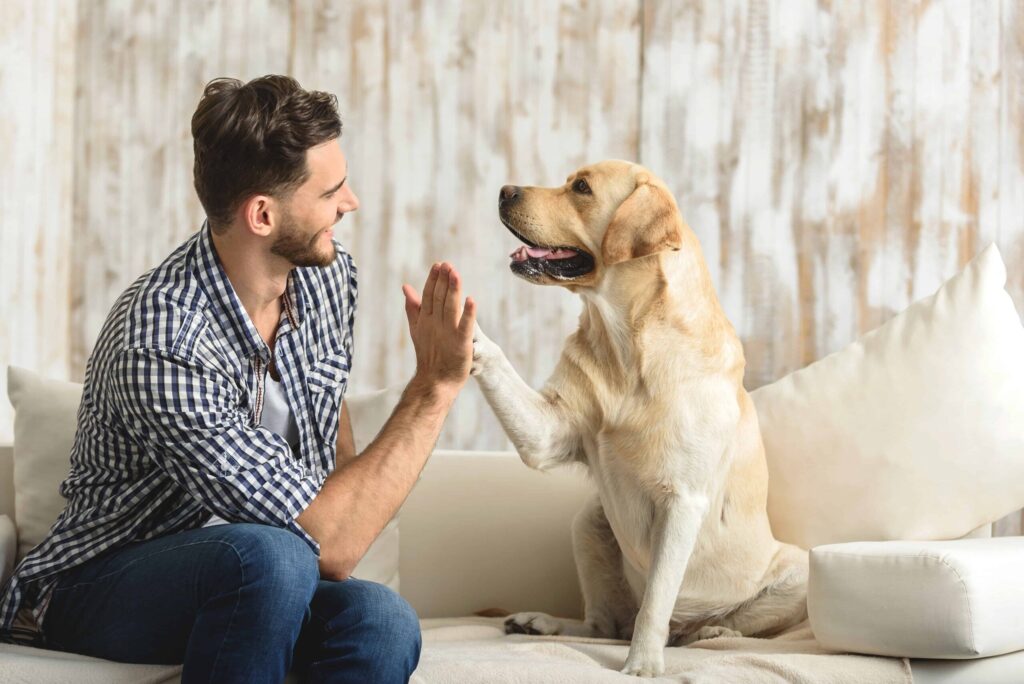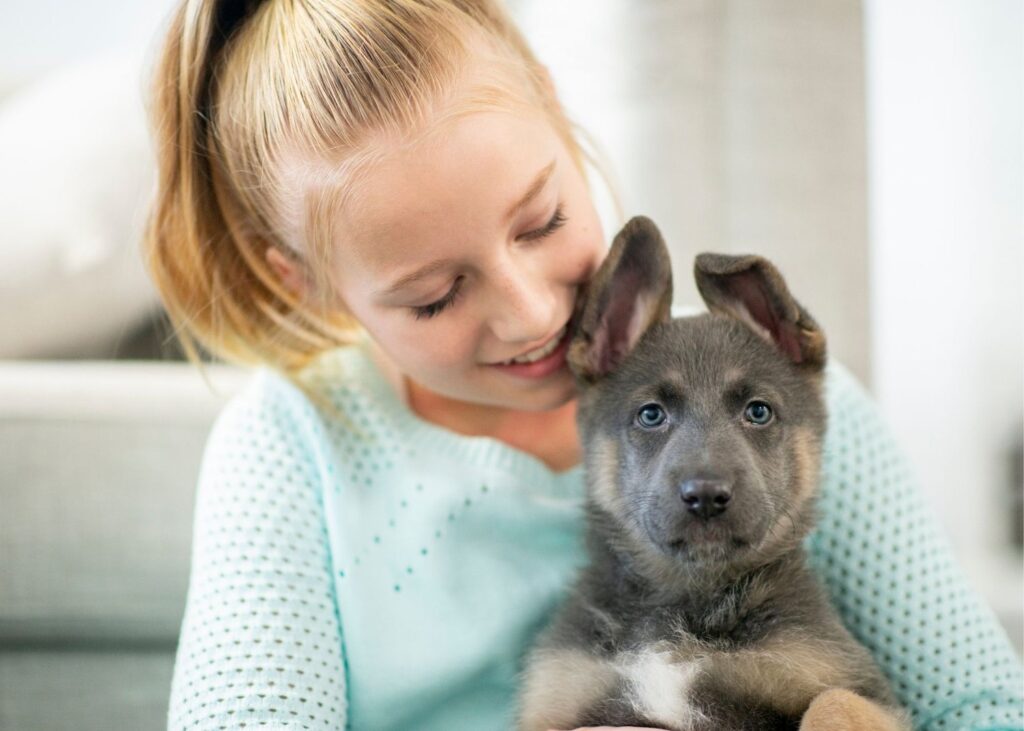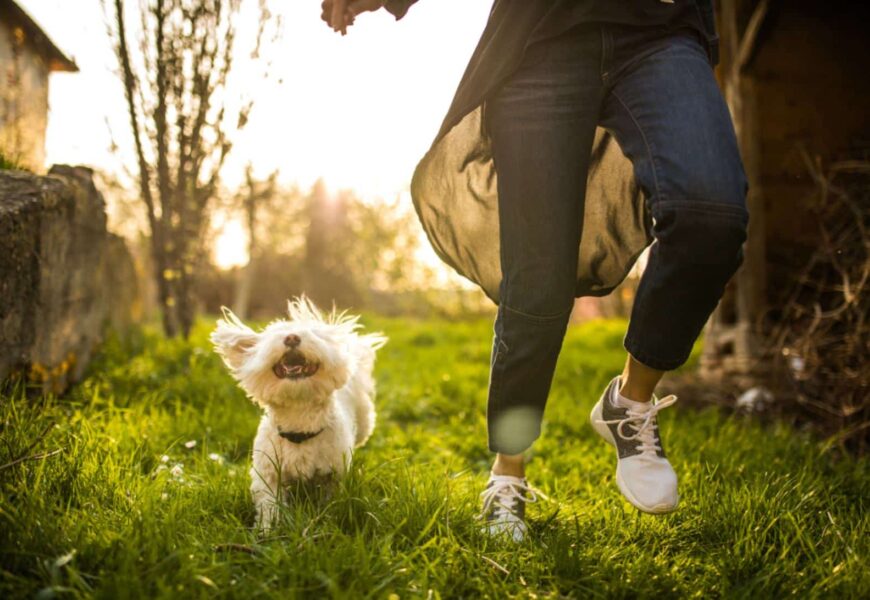“the Heartwarming Secrets: How Bonding with Your Pet Transforms Ordinary Moments into Extraordinary Connections.”
Key Takeaways:
- Understand your pet’s needs and behavior for a strong bond.
- Create a safe and comfortable environment for your pet’s well-being.
- Use positive reinforcement training for desirable behavior.
- Spend quality time together and engage in interactive play.
- Explore the outdoors and enjoy nature bonding.
- Provide relaxation and affectionate bonding through petting and a calm presence.
- Be patient and understanding with rescued pets or those with separation anxiety.
- The human-pet bond has healing power, reducing stress and loneliness.
- Pets offer unconditional love and emotional support.
A unique and heartwarming connection forms between humans and their beloved pets—a bond that goes beyond the mere owner-pet relationship. For those of us who share our lives with furry, feathered, or scaly companions, it’s no secret that these special beings hold a cherished place in our hearts. Whether it’s the comforting presence of a loyal dog, the independent yet affectionate purrs of a cat, the melodic chatter of a colorful bird, or the gentle trust of a small animal like a rabbit or guinea pig, each pet brings a distinctive blend of joy, love, and companionship into our lives.
In this article, we delve into the art of bonding with your pet and explore the secrets to building a strong and loving relationship. We’ll venture into the world of understanding their needs and behavior, deciphering their communication cues, and creating a haven for them to thrive. From playful activities that foster a sense of camaraderie to the simple joys of shared moments, we’ll uncover ways to enhance the connection you share with your furry friend. Moreover, we’ll discover how our pets give back to us in their mysterious way—nurturing our mental and emotional well-being and even offering therapeutic healing.
So, whether you’re a seasoned pet parent or contemplating bringing a new companion, join us as we embark on a journey of love, trust, and profound understanding. Through the bond we form with our pets, we realize that these incredible creatures truly become part of our families, teaching us invaluable lessons in compassion, patience, and the enduring power of unconditional love.
Understanding Your Pet’s Needs and Behavior
Recognizing Species-Specific Traits
Dogs: Pack Animals and Loyalty
Dogs have earned their reputation as loyal companions for a reason – their innate pack mentality. Descendants of wolves, dogs are hardwired to form close bonds with their human family, treating them as members of their pack. This pack dynamic translates into their loyalty, unwavering devotion, and eagerness to please their human “pack leaders.” Dogs thrive in a structured and social environment where they feel included and valued. Regular interaction, consistent training, and positive reinforcement strengthen the bond between humans and their canine friends, creating a sense of trust and understanding.
Cats: Independent Spirits and Affection
Unlike their more pack-oriented counterparts, cats possess an independent and solitary nature. Feline companions value their personal space and autonomy, but that doesn’t mean they don’t form strong bonds with their human caregivers. Cats may show affection subtly, such as head-butting, kneading, or purring. Their ability to choose when and how they want attention allows for a deeper level of mutual respect and trust to develop. Understanding and respecting a cat’s need for alone time and providing them with enriching activities, like interactive toys and scratching posts, help nurture a harmonious and affectionate relationship.
Birds: Social Interaction and Communication
Birds are highly social creatures that thrive on interaction, both with their fellow birds and their human companions. Their ability to mimic sounds and vocalize makes communication with their owners an engaging experience. Parrots, for instance, can form strong emotional bonds with their caregivers, treating them as part of their flock. Regular socialization, mental stimulation through puzzles or training exercises, and allowing birds to participate in family activities contribute to fulfilling their social needs, enabling a deeper sense of companionship.
Small Animals (e.g., Rabbits, Guinea Pigs): Bonding through Trust
Smaller animals like rabbits and guinea pigs may not be as expressive as dogs or cats, but they, too, have unique needs and ways of building relationships. These gentle creatures rely on trust as the foundation for bonding with their human caretakers. A safe and enriching environment where they can explore, play, and interact helps build this trust. Gentle handling, offering their favorite treats, and spending quality time near their enclosure allows these small animals to grow comfortable with human presence and form strong bonds rooted in trust.
Observing Body Language and Communication Cues
Canine Body Language
Understanding a dog’s body language is key to interpreting their emotions and needs. Wagging tails, for instance, don’t always signify happiness. The tail’s speed, height, and position can indicate excitement, nervousness, or even potential aggression. Other cues, such as ear positioning, eye contact, and body position, offer insights into a dog’s mood and intentions. Floppy, relaxed ears and a loose body typically convey calmness, while a stiff posture and direct eye contact may indicate alertness or assertiveness. Paying close attention to these cues helps us respond appropriately to our canine companions, fostering a sense of trust and security in their interactions with us.
Feline Communication Signals
Cats are masters of non-verbal communication, and their body language speaks volumes about their feelings. A cat’s tail, for instance, is a significant indicator of its emotional state. A raised tail reflects contentment, while a puffed-up tail signals fear or agitation. Similarly, the position of their ears, their pupils’ dilation, and their whiskers’ movement all contribute to their expressions. Additionally, the tone and intensity of their vocalizations convey specific messages, from the friendly chirps and meows to the more urgent yowls and hisses. Being attuned to these subtle cues allows us to understand our feline friends better, strengthening the bond of trust and deepening our connection with them.
Avian Vocalizations and Gestures
Birds use a combination of vocalizations and gestures to communicate their needs and emotions. Their vocal repertoire may include chirps, whistles, squawks, and even mimicry of human speech. Different tones and patterns in their vocalizations can convey joy, contentment, fear, or agitation. Alongside their vocal expressions, birds communicate with various body gestures and movements. For instance, a bird fluffing up its feathers might signify feeling threatened or unwell, while gentle head-bobbing can indicate curiosity or excitement. Being attentive to these intricate forms of avian communication allows us to better understand our feathered companions and strengthen our bond with them.
Building Trust and Respect: Nurturing a Strong Bond with Your Pet

Establishing a Safe and Comfortable Environment
As pet owners, one of our primary responsibilities is to create an environment that fosters a sense of safety and comfort for our furry friends. Building trust begins with providing the essential elements they need to thrive physically and emotionally.
Providing a Cozy Shelter:
A cozy shelter is the foundation of your pet’s sense of security. Whether it’s a dog crate, a cat condo, a birdcage, or a small animal enclosure, ensure that it is well-suited to their size and needs. Offer a warm and inviting space that serves as their haven, where they can retreat and rest when needed. Having a designated shelter gives them a sense of ownership and establishes a place where they can feel safe during stressful situations.
Ensuring a Balanced Diet and Health Care:
Proper nutrition and regular health check-ups are vital for your pet’s well-being. Consult with a veterinarian to determine the right diet for your pet’s specific breed and age, and ensure they receive all necessary vaccinations and preventive care. A healthy and balanced diet contributes to their physical health and positively impacts their emotional state. Regular vet visits also help detect any health issues early on, fostering trust as your pet knows they will be cared for.
Regular Exercise and Enrichment Activities:
Physical activity and mental stimulation are crucial for your pet’s overall happiness. Dogs, for example, benefit greatly from daily walks and playtime, while cats enjoy toys that tap into their natural hunting instincts. Birds thrive on activities challenging their intelligence, such as puzzle toys or training sessions. For smaller animals like rabbits and guinea pigs, providing tunnels and hiding spots stimulates their instincts and allows them to explore. Regular exercise and enriching activities help channel their energy positively, preventing boredom and fostering a sense of contentment and trust in their environment.
Practicing Positive Reinforcement Training
Positive reinforcement is a powerful tool for teaching your pet desirable behaviors and building trust through positive associations. It involves rewarding your pet for exhibiting behaviors you want to encourage.
Reward-Based Training Methods:
Positive reinforcement relies on rewards such as treats, praise, or affection whenever your pet displays the desired behavior. For instance, when teaching a dog to sit, reward them with a treat and praise them when they do so. This positive association motivates them to repeat the behavior, deepening the bond between you and your pet.
Consistency and Patience in Training:
Consistency is key to effective positive reinforcement training. Set clear and achievable goals for your pet and be patient in their learning process. Avoid punishment-based techniques, which can erode trust and lead to fear-based responses. Instead, be understanding and patient with your pet, consistently celebrating their progress and reinforcing good behavior.
Allowing for Independence and Boundaries

Just like humans, pets also appreciate their independence and personal space. Respecting their boundaries contributes to a stronger sense of trust and mutual respect.
Respecting Personal Space:
Observe your pet’s body language and cues to understand when they need alone time or space. For example, if your cat retreats to a quiet corner or your bird tucks its head under its wing, it’s a sign that they desire solitude. Giving them the freedom to have their own space reinforces the notion that you respect their needs and boundaries.
Encouraging Freedom of Movement:
Pets, especially dogs, thrive on freedom of movement. Allow them to explore their surroundings indoors and outdoors (if safe and appropriate). Regular walks, playtime in a secure yard, or outdoor excursions for birds on harnesses all contribute to a healthy and enriched life. Giving your pet the freedom to roam and explore helps them build confidence and trust in you as their caregiver.
Quality Time and Shared Activities: Strengthening the Bond with Your Beloved Pet
The Power of Play and Fun
Playtime is not just a frivolous activity; it’s a cornerstone of the human-pet relationship. Engaging in interactive play with your pet brings joy and fun and fosters a deeper connection between you and your furry friend.
Engaging in Interactive Playtime:
Whether you have a bouncy dog, a playful cat, a chirpy bird, or a curious small animal, interactive playtime is essential for their physical and mental well-being. For dogs, fetch, tug-of-war, and hide-and-seek are exhilarating games that allow them to use their instincts. Cats enjoy chasing toys that mimic prey, such as feather wands or laser pointers, which satisfy their natural hunting drive. Birds love toys that encourage problem-solving, like puzzle feeders, while small animals benefit from items that encourage exploration and curiosity, such as tunnels and treat-dispensing toys. Engaging in these activities keeps your pet physically active and strengthens the bond as you become an integral part of their play and enjoyment.
Choosing the Right Toys for Mental Stimulation:
Toys aren’t just meant for physical play; they can also provide valuable mental stimulation for your pet. Puzzle and treat-dispensing toys challenge your pet’s cognitive abilities and keep their minds sharp. The act of problem-solving and the reward of obtaining treats from these toys give them a sense of accomplishment and satisfaction, contributing to their overall happiness. Mental stimulation is especially crucial for intelligent breeds and animals with high mental acuity, such as parrots and rabbits. By offering toys that cater to their specific needs, you provide them with an outlet for their intellectual curiosity, fostering a deeper sense of fulfillment in their daily lives.
Exploring the Great Outdoors Together
The great outdoors offers you and your pet many sensory experiences and enrichment opportunities. Going on outdoor adventures together promotes physical health and provides an opportunity for nature bonding and shared experiences.
Outdoor Adventures and Walks:
For dogs, daily walks are more than just bathroom breaks; they are a chance for exploration, exercise, and socialization. Walking your dog in different environments exposes them to new sights, smells, and sounds, stimulating their senses and keeping them mentally engaged. It’s also an opportunity to bond and build trust as you navigate the world together. Additionally, meeting other dogs and people during walks allows your furry companion to practice positive social interactions, enhancing their social skills.
Nature Bonding for Birds and Small Animals:
Birds and small animals can also benefit from outdoor excursions but with appropriate safety precautions. Harness training allows birds to experience the outdoors while ensuring their safety. Taking rabbits, guinea pigs, or other small animals on supervised outdoor playtime in a secure enclosure enables them to explore grassy areas and enjoy fresh air. Being in nature together creates a unique bond and enriches their lives, making them more confident and content.
Relaxation and Affectionate Bonding

Amidst all the activities and adventures, it’s essential to make time for relaxation and affectionate bonding with your pet. These moments of intimacy create a sense of security and deepen your emotional connection.
Petting and Massage for Stress Relief:
Gentle petting and massages can be incredibly soothing for pets and their human companions alike. Dogs and cats, in particular, enjoy being stroked or massaged, which can alleviate stress and anxiety. Massaging your pet can also have physical benefits, such as promoting blood circulation and muscle relaxation. For some birds, gentle head scratches or feather grooming can be highly pleasurable, strengthening the bond between bird and owner. Understanding your pet’s preferences and providing affection in a way they enjoy fosters a profound sense of trust and relaxation.
The Soothing Effect of Calm Presence:
Sometimes, the most meaningful bonding moments with your pet involve simply being present with them in a calm and reassuring manner. Whether it’s sitting quietly beside your cat as they nap, sharing quiet moments with a bird on your shoulder, or cuddling with your small animal friend, the power of your peaceful presence cannot be underestimated. Your pet can sense your emotions and energy, and by being calm and reassuring, you communicate a sense of safety and security, which in turn strengthens the bond of trust between you.
Overcoming Challenges in Bonding: Nurturing Trust and Connection with Your Rescued or Anxious Pet
Past Traumas and Rescued Pets
Adopting a rescued pet can be a transformative experience for both the animal and the new owner. While giving a home to a rescued pet is a compassionate act, it may come with unique challenges due to their past traumas and uncertainties. Building a strong bond with a rescued pet requires patience, understanding, and a willingness to earn their trust.
Adopting Rescued Animals: Patience and Understanding
Rescued animals may have experienced neglect, abuse, or abandonment, which can lead to fear, anxiety, and defensive behaviors. As an owner, it’s essential to be patient and understanding during the initial stages of the bonding process. Give your pet the space they need to acclimate to their new surroundings, and avoid overwhelming them with too much attention or interaction. Allow them to approach you at their own pace, and respect their need for time to feel safe in their new home.
Earning Trust and Rebuilding Confidence
Earning the trust of a rescued pet is a gradual process that requires consistent, gentle interactions. Use positive reinforcement to reward any sign of progress or positive behavior. Offer treats, praise, or affection when your pet shows curiosity or a willingness to engage. Avoid forcing interactions or pushing them into situations that may trigger fear. Instead, focus on creating positive associations between you and their new environment. As your rescued pet begins to feel more secure and confident, the bond between you will naturally strengthen.
Separation Anxiety and Long Hours
Pet owners frequently struggle with separation anxiety, especially when they have to leave their animals alone for extended periods of time. Whether it’s due to work commitments or other obligations, it’s essential to address separation anxiety and provide enrichment to keep your pet engaged and content in your absence.
Coping Strategies for Absence and Departures
To help your pet cope with your absence, establish a consistent routine that includes a calm and reassuring departure and return. Create a designated safe space for your pet, such as a cozy crate or a specific room, where they can feel secure while you’re away. Leave them with familiar items like their favorite toys, blankets, or clothing with your scent to offer comfort during your absence. Consider leaving soft background music or white noise to help soothe their nerves.
It’s also essential to avoid making a big deal out of leaving or returning home. Keep your departures and arrivals low-key to minimize the emotional impact of these events. By normalizing your departures and making them less stressful, you can gradually reduce separation anxiety.
Enrichment Techniques for Solo Play
Providing enrichment activities for your pet during solo playtime can be an effective way to alleviate boredom and anxiety. Puzzle toys, interactive feeders, and treat-dispensing toys can engage your pet’s mind and provide a stimulating challenge. These toys not only keep them mentally active but also serve as a positive distraction in your absence.
For dogs, consider leaving them with long-lasting chew toys or frozen treats to keep them occupied. Cats may enjoy interactive toys that mimic prey or cat trees and scratching posts for climbing and exploring. Birds and small animals can benefit from toys that encourage problem-solving and foraging, such as puzzle feeders or hiding treats in their enclosure.
In addition to toys, consider providing audio or visual stimulation for your pet. For instance, leaving on soothing music or playing nature videos can create a calming atmosphere and make your pet feel less alone.
The Healing Power of the Human-Pet Bond: Nurturing Mental and Emotional Well-Being
The Role of Pets in Mental and Emotional Well-Being

The human-pet bond is a profound and transformative relationship that extends far beyond companionship and fun. Our furry, feathered, or scaled friends have a remarkable impact on our mental and emotional well-being, offering solace, support, and a source of joy in our lives.
Stress Reduction and Anxiety Relief:
The simple act of spending time with our pets can trigger a cascade of positive physiological responses. Studies have shown that petting a dog or cat can lower cortisol levels, the hormone associated with stress. The rhythmic motion of stroking a pet’s fur can induce a sense of calm and relaxation, reducing feelings of anxiety and promoting emotional well-being. Merely being in the presence of our pets can provide a soothing effect, allowing us to momentarily escape the pressures of daily life.
Alleviating Loneliness and Depression:
Pets are natural companions, and their unwavering presence can be a lifeline for individuals experiencing loneliness or depression. The non-judgmental and unconditional love they offer creates a sense of connection and belonging. For those going through challenging times or facing social isolation, the company of a beloved pet can be a vital source of comfort, lifting spirits and fostering feelings of happiness.
Boosting Mood and Happiness:
Interacting with pets releases oxytocin, often referred to as the “love hormone” or “bonding hormone.” Oxytocin is associated with feelings of attachment, trust, and happiness. Engaging in activities like playing, cuddling, or simply watching our pets can trigger the release of oxytocin, leading to an improved mood and a sense of contentment. Our pets’ daily dose of happiness can be a potent antidote to life’s difficulties.
Pet Therapy and Assistance Animals
The profound healing power of the human-pet bond has been recognized beyond individual pet owners, leading to the development of pet therapy programs and the use of assistance animals in various settings.
Pet Therapy:
Pet therapy, also known as animal-assisted therapy, involves trained animals visiting healthcare facilities, schools, or other settings to provide comfort and companionship to people in need. Interactions with therapy animals have been shown to reduce stress, anxiety, and pain in patients, enhance social interactions, and improve emotional well-being. For example, therapy dogs have been used to help children with developmental disabilities, veterans with PTSD, and seniors in nursing homes. The unconditional love and presence of therapy animals can create an environment of emotional support and healing.
Assistance Animals:
Assistance animals, such as service dogs or emotional support animals, are trained to perform specific tasks to aid individuals with disabilities or mental health conditions. Service dogs, for instance, can help people with mobility challenges by providing support or retrieving items. Emotional support animals provide comfort and companionship to individuals with conditions like anxiety, depression, or PTSD. These animals not only assist their owners practically but also offer emotional stability and comfort, serving as a vital part of their mental health support system.
Unconditional Love and Emotional Support
One of the most remarkable aspects of the human-pet bond is our pets’ unconditional love and emotional support. They accept us wholly without judgment, providing a safe space to express our feelings and vulnerabilities.
A Source of Unconditional Love:
Pets do not hold grudges or have expectations; their love is unwavering and unconditional. Regardless of our flaws or imperfections, our pets see us for who we are and accept us wholeheartedly. This non-judgmental love can be incredibly healing, offering us a sense of self-worth and value.
Easing Emotional Burdens:
It can be a constant source of comfort during times of sadness, stress, or grief. They sense our emotional states and respond empathetically, often cuddling close or offering gentle nudges. Being present with a pet and feeling their warmth and affection can provide a sense of solace and alleviate emotional burdens.
Conclusion
Understanding your pet’s unique needs and behaviors is the foundation for building a strong and loving relationship. Each species brings its distinct qualities and methods of communication to the table, and by embracing and respecting these individual traits, we can create a harmonious and fulfilling bond with our beloved animal friends. Through keen observation, patience, and genuine affection, we embark on a journey of mutual understanding and companionship, transcending the barriers between the human and animal worlds.
Building trust and respect with your pet is an ongoing process that requires patience, understanding, and consistent effort. By providing a safe and comfortable environment, practicing positive reinforcement training, and respecting their need for independence and boundaries, you can lay a strong foundation for a loving and harmonious relationship with your furry companion. Remember that each pet is unique, and it may take time to develop trust and a deep bond, but the journey is both rewarding and fulfilling as you watch your pet flourish in a secure and loving environment.
Spending quality time and engaging in shared activities with your pet is at the heart of building a strong and meaningful relationship. From interactive play and mental stimulation to outdoor adventures and relaxing moments of affection, each experience contributes to your unique bond with your beloved companion. Remember that these activities bring joy and happiness to your pet’s life and enrich your own, creating cherished memories and an unbreakable connection that will last a lifetime.
Building a strong bond with a rescued or anxious pet comes with its own unique challenges, but with patience, understanding, and dedication, you can overcome these obstacles. You can create a loving and secure relationship by earning their trust and providing them with a safe and enriched environment. Addressing separation anxiety and offering engaging enrichment activities during solo playtime will keep your pet content in your absence and strengthen your connection when you’re together. Remember that every pet is an individual, and finding what works best for your furry friend may require trial and error. Embrace the journey of bonding with your pet, and with time, you’ll witness the beautiful transformation of a scared or anxious pet into a confident and loving companion.
The human-pet bond possesses an extraordinary healing power, enriching our lives in immeasurable ways. Our pets become more than just animals; they become confidants, supporters, and emotional anchors. From stress reduction and anxiety relief to the profound impact of pet therapy and assistance animals, our connection with our pets nurtures our mental and emotional well-being. Their unconditional love is a constant reminder of the beauty of life and the transformative influence of compassion and companionship. Embracing the healing power of the human-pet bond allows us to cherish and celebrate our remarkable relationship with our beloved animal friends.




